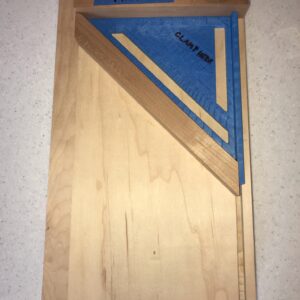I built the shooting board that Mike Pekovich describes in his “Essential Jigs” video. The one with the plastic speed square for 45 degree miters.
I have a hard time holding smaller work pieces in place with my hand while shooting the plane (I’ve had multiple neck surgeries and my arm strength isn’t what it used to be.)
Question: has anyone come up with a good way of clamping pieces to the shooting board? I was considering making some type of adjustable sliding clamp that would attach to the face of the shooting board, and would slide up against the workpiece and hold it in place. Anyone done this yet? Photos or info welcome!
thanks.
Update: added a photo. The speed square rides in a dado in the board and is removable. To elaborate, yes, the “clamp” would be momentary, just something to allow more pressure to be applied along the lower edge of the workpiece when shooting. I’m considering making an angled piece of MDF with a small rail that would also slide in the dado and then snug up to the workpiece.
Discussion Forum
Get It All!
UNLIMITED Membership is like taking a master class in woodworking for less than $10 a month.
Start Your Free TrialCategories
Discussion Forum
Digital Plans Library
Member exclusive! – Plans for everyone – from beginners to experts – right at your fingertips.
Highlights
-
Shape Your Skills
when you sign up for our emails
This site is protected by reCAPTCHA and the Google Privacy Policy and Terms of Service apply. -
 Shop Talk Live Podcast
Shop Talk Live Podcast -
 Our favorite articles and videos
Our favorite articles and videos -
E-Learning Courses from Fine Woodworking
-
-
 Fine Woodworking New England Event
Fine Woodworking New England Event -













Replies
I have not tried this but it seems a t-track inset in the base with appropriate clamps would work
Hmm, I'm having a bit of trouble picturing how one would clamp the work piece to the shooting board and still be able to move it toward the "toe" of the plane (before the blade) after the first or second "shoot." Unless one would un-clamp and move it after every swipe. Could you explain a little more? (maybe installing a wedge-shape to be tapped lightly with a brass hammer after every swipe?)
Txs, I updated my post. I understand your comments. I had issues when shooting harder woods (oak) picture frame miters. The idea is to provide more “purchase” when pushing against the workpiece. I don't have much gripping strength in my hand.
I’ve had success using a short length of double-sided tape. A few light taps with a bench mallet will advance the work piece without detaching it from the shooting board. You should be able to easily get up to 5/16”+ of movement. Depending on the amount of friction needed to help hold the work piece in place, you could channel Bob Van Dyke and lick your fingers and apply board spit as an adhesive between swipes with the plane.
Txs, I’ll try it. I updated my post also.
I have a pair of work gloves with tacky coating on the palm and fingers which help holding and feeding the wood into the cut
Thank you, I’ll try it.
Maybe I should use some “Spider Grip” like the major league pitchers do!! 😃
Allegedly...
Is there a batten for holding the shooting board in the bench vise? I could not tell in the picture. If the batten is on a long side as in Tim Rousseau's shooting board, you could use an "F" clamp to hold the work being planed. Depending on where your bench vise is, you could probably do the same if the batten is on the top or bottom, short side. That way you can keep it simple without adding more dados or hardware and accomplish the same thing.
I tried this with squares purchased at the home center and none of them were accurate enough. +/- a degree or two is no big deal when framing a house. I need a shooting board to be dead on.
You can adjust out small degrees of error in the square when you screw the hardwood piece to it, as per Mike’s design.
Lots of folks don't eventually together the shooting board perfect, because it may not stay that way. They use tiny shims, either scraps of paper or playing card, to dial in the perfect angle.
Make an angled piece to take the place of the speed square and glue sandpaper to the edge where your workpiece makes contact. You won’t have any slippage on your workpiece and the effort to hold it in place is minimal. This works effortlessly for me. My grip isn’t what it used to be. You can also add sandpaper to your angled piece where it contacts the fence of the shooting board to keep it from moving.
Thanks!
This forum post is now archived. Commenting has been disabled